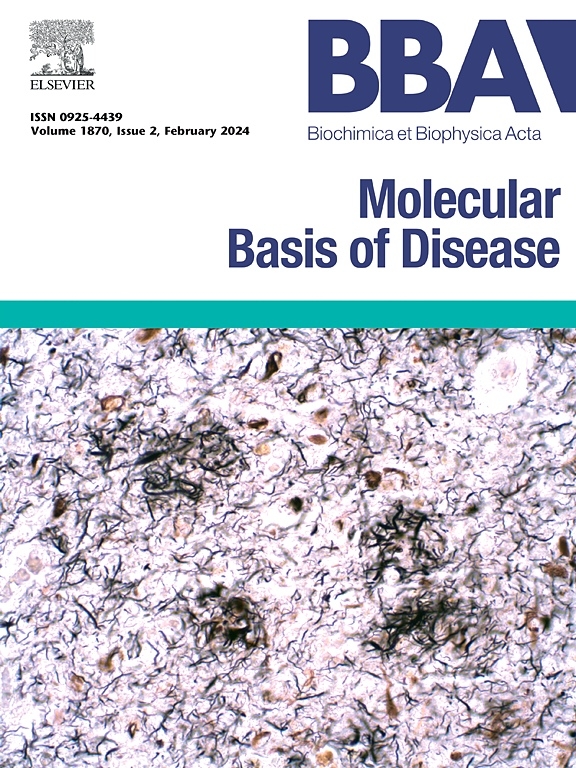Motor protein KIF5B inhibition as a novel strategy of controlled reperfusion against myocardial ischemia/reperfusion injury
IF 4.2
2区 生物学
Q2 BIOCHEMISTRY & MOLECULAR BIOLOGY
Biochimica et biophysica acta. Molecular basis of disease
Pub Date : 2025-03-07
DOI:10.1016/j.bbadis.2025.167785
引用次数: 0
Abstract
Metabolic dysregulation triggered by nutrient influx at reperfusion onset induces reactive oxygen species (ROS) burst and cellular injury, contributing to the detrimental effects observed in ischemia/reperfusion (I/R) injury. Thus, implementing controlled reperfusion emerges as a superior cardioprotective strategy to alleviate reperfusion injury. Kinesin KIF5B transports GLUT4- and CD36-containing vesicles to the plasma membrane, facilizing the import of glucose and fatty acids into cells, suggesting a role in controlled reperfusion. Herein, we aim to investigate its specific role in myocardial I/R injury. By genetic and pharmacological modulation of KIF5B, we investigated its role in myocardial I/R injury both in vivo and in vitro. During reperfusion, a coordinated inhibition of metabolism-related genes and KIF5B expression occurred, probably mitigating the metabolic stress encountered as a compensatory mechanism. Genetic inhibition of KIF5B using AAV9-shRNA attenuated myocardial I/R injury, as evidenced by reduced infarct size, decreased cardiac biomarkers, and reduced cell apoptosis. Additionally, KIF5B inhibition mitigated post-reperfusion oxidative stress and arrhythmias. Mechanistically, concurrent decrease in CD36 membrane translocation following KIF5B ablation post-reperfusion was confirmed by immunofluorescence double staining, and siRNA knockdown of Kif5b inhibited fatty acids uptake in isolated primary neonatal rat cardiomyocytes. Intraperitoneal administration of rose bengal lactone (RBL, 1 mg/kg), a selective inhibitor of KIF5B, was shown to confer cardioprotective effects against myocardial I/R injury. Our findings demonstrate that the inhibition of KIF5B, as a novel strategy of controlled reperfusion, provides cardioprotection against myocardial I/R injury, and highlights the clinical potential of its inhibitor, RBL, to ameliorate reperfusion injury.

抑制运动蛋白KIF5B作为控制再灌注对抗心肌缺血/再灌注损伤的新策略
再灌注时营养流入引发的代谢失调可诱导活性氧(ROS)爆发和细胞损伤,从而对缺血/再灌注(I/R)损伤产生不利影响。因此,实施控制再灌注成为一种更好的心脏保护策略来减轻再灌注损伤。Kinesin KIF5B将含有GLUT4-和cd36的囊泡转运到质膜,促进葡萄糖和脂肪酸进入细胞,提示在控制再灌注中起作用。本文旨在探讨其在心肌I/R损伤中的具体作用。通过基因和药理调控KIF5B,我们研究了其在体内和体外心肌I/R损伤中的作用。在再灌注过程中,代谢相关基因和KIF5B表达发生协同抑制,可能作为一种代偿机制减轻了所遇到的代谢应激。使用AAV9-shRNA基因抑制KIF5B可减轻心肌I/R损伤,这可以通过减少梗死面积、降低心脏生物标志物和减少细胞凋亡来证明。此外,KIF5B抑制可减轻再灌注后氧化应激和心律失常。机制上,免疫荧光双染色证实,再灌注后KIF5B消融后CD36膜易位同时减少,siRNA敲低KIF5B抑制了离体初代新生大鼠心肌细胞的脂肪酸摄取。研究显示,腹腔注射KIF5B选择性抑制剂玫瑰内酯(RBL, 1 mg/kg)对心肌I/R损伤具有心脏保护作用。我们的研究结果表明,抑制KIF5B作为一种控制再灌注的新策略,可对心肌I/R损伤提供心脏保护,并强调其抑制剂RBL在改善再灌注损伤方面的临床潜力。
本文章由计算机程序翻译,如有差异,请以英文原文为准。
求助全文
约1分钟内获得全文
求助全文
来源期刊
CiteScore
12.30
自引率
0.00%
发文量
218
审稿时长
32 days
期刊介绍:
BBA Molecular Basis of Disease addresses the biochemistry and molecular genetics of disease processes and models of human disease. This journal covers aspects of aging, cancer, metabolic-, neurological-, and immunological-based disease. Manuscripts focused on using animal models to elucidate biochemical and mechanistic insight in each of these conditions, are particularly encouraged. Manuscripts should emphasize the underlying mechanisms of disease pathways and provide novel contributions to the understanding and/or treatment of these disorders. Highly descriptive and method development submissions may be declined without full review. The submission of uninvited reviews to BBA - Molecular Basis of Disease is strongly discouraged, and any such uninvited review should be accompanied by a coverletter outlining the compelling reasons why the review should be considered.

 求助内容:
求助内容: 应助结果提醒方式:
应助结果提醒方式:


